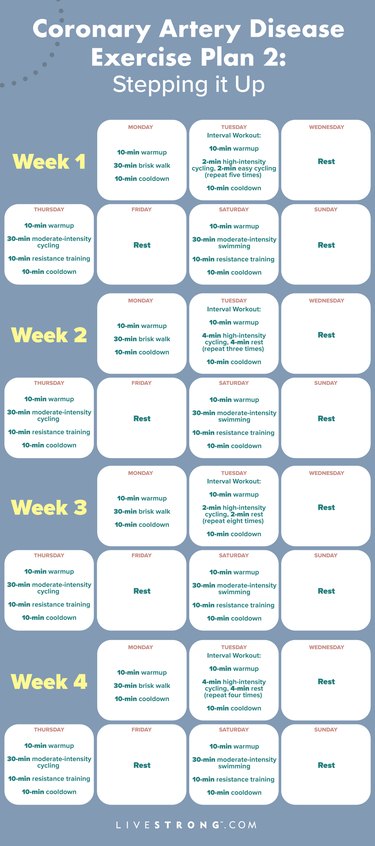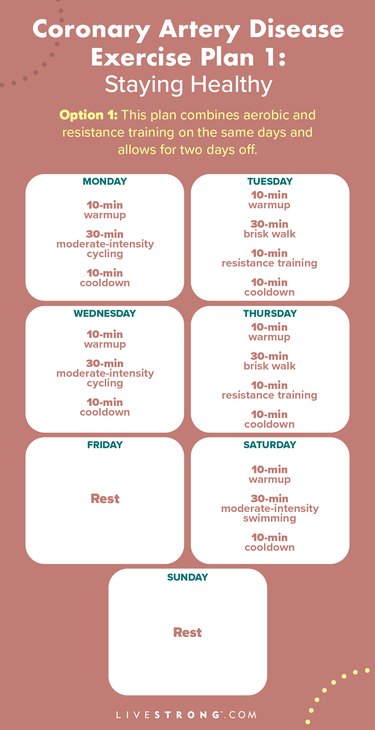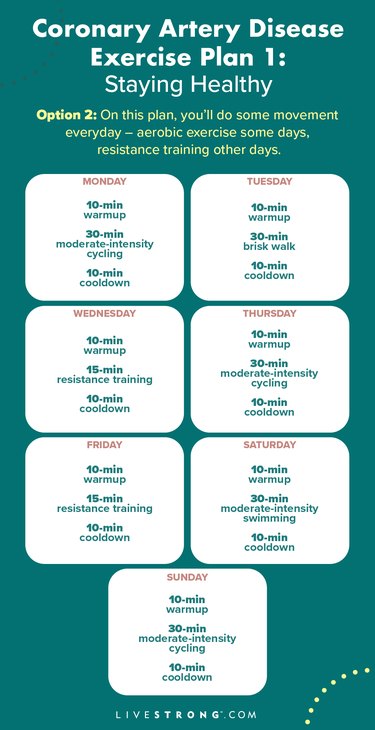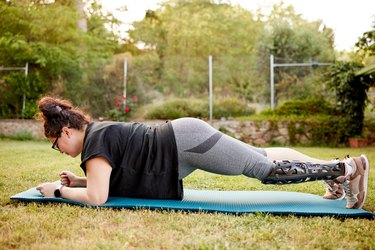



Exercise is one of the best ways to keep your heart healthy and prevent cardiovascular disease. But if you have heart disease — especially coronary artery disease, the most common type — you might be wondering if exercise can reverse your diagnosis.
Coronary artery disease typically occurs when a sticky, waxy substance called plaque builds up in your coronary arteries, which supply blood to your heart. If left untreated, plaques can grow or break off and then completely block blood vessels, causing heart attacks.
Video of the Day
Video of the Day
Exercise doesn't magically melt away these plaques or "cure" heart disease, cardiologist Tom Sarma, MD, associate professor in the department of internal medicine at UT Southwestern Medical Center, says. However, it can reduce symptoms, prevent progression and extend your life.
"We prescribe [exercise], and I usually tell people it's more important than any one medication that you're on, although the medications are also very important," cardiologist Allison Zielinski, MD, assistant professor, co-director of the sports cardiology program and medical director of cardiac rehab at Northwestern Medicine, says.
Here's what you need to know about the benefits, risks and limitations of exercise with coronary artery disease — and the best ways to get started on a program.
Exercise can't completely reverse heart disease — nothing can. But it can reduce symptoms, prevent progression and extend your life.
The Limitations of Exercise on Heart Disease
Exercise can't technically reverse heart disease. "If someone is diagnosed with a 50 percent obstruction in one of their coronary blood vessels, unfortunately, exercise is not going to get rid of that obstruction completely," Dr. Momin says. It might shrink it some, but not to the degree of disappearing.
in January 2018, Dr. Sarma and his colleagues published a study in Circulation showing two years of structured physical activity, including high-intensity intervals, could reverse some of the cardiac effects of being sedentary in middle-aged adults, restoring elasticity to stiffened heart tissue.
This could ward off coronary artery disease, heart failure and other conditions if you don't already have them. However, once you've been diagnosed, the terminology changes. "The word cure is a challenging concept," Dr. Sarma says, not one that's typically applied to heart disease. "We can manage heart disease, and we can limit the effects so that you can live a healthy life."
In addition, working out isn't a substitute for other treatments. Physical activity typically works best as part of a comprehensive approach to managing heart disease, which might involve dietary changes; medications; stents or other procedures; reducing stress; and controlling risk factors like high blood pressure and high cholesterol, Dr. Hirsh says.
What Exercise Can Do for Your Heart
When you're diagnosed with coronary artery disease, you and your medical team will create a plan to manage your condition. This may include medications, placing mesh tubes called stents inside your arteries and lifestyle changes, including physical activity.
"Exercise should be viewed as a daily medical treatment," Benjamin Hirsh, MD, director of preventive cardiology at Sandra Atlas Bass Heart Hospital at North Shore University Hospital and medical director of cardiac rehabilitation at Northwell Health, says. "There's just so many good benefits to it." For people with coronary artery disease, physical activity can:
1. Keep chest pain and other symptoms at bay.
Your heart supplies oxygen-rich blood to the rest of your body, but like any muscle, it needs oxygen itself to function; in fact, it needs a lot of it, since it's beating 24/7, Dr. Sarma says.
When your heart is oxygen-starved, you might feel aching, squeezing, pain or tightness in your chest. The medical term for this condition is angina, and it's one of the main symptoms of coronary artery disease.
While physical activity often triggers angina in the moment, it's also key to reducing it over the long term, Dr. Zielinski says. With regular activity, your heart becomes a stronger, more efficient pump, delivering a greater surge of oxygen-rich blood throughout your body with each beat. You'll also increase the volume of blood in your body, and your muscles change in a way that allows you to extract more oxygen from each pint.
All these adaptations mean you can push harder and longer before symptoms set in. The key is to progress at the right rate, so you're gently challenging your body (with your doctor's supervision, of course), says Wafi Momin, DO, cardiologist at UTHealth Houston Heart & Vascular and Memorial Hermann.
Physical activity can also reduce other symptoms and complications of heart disease, Dr. Hirsh says. Notably, it can improve depression and anxiety. According to the National Heart, Lung, and Blood Institute, depression can occur as a result of heart disease and also worsen your prognosis. And the same is true for anxiety, according to a November 2017 review in Current Psychiatry Reports.
2. Ward off heart attacks and other cardiovascular events.
"One of the key factors that drives plaque accumulation is what we call endothelial dysfunction, or damage of the lining of the blood vessels of the coronary arteries," Dr. Sarma says. "Exercise somehow seems to protect that lining, which is something that, really, none of our medications can do."
The healthier the lining, the more easily your blood vessels can widen and narrow to control your blood flow and blood pressure. This puts less demand on your heart over time, decreasing the chances of having a cardiac event, Dr. Momin says.
In addition, exercise (especially when combined with medicines) stabilizes plaques, making them harder and more calcified. That's good news, because softer plaques are more likely to rupture and cause a heart attack, Dr. Zielinski says.
3. Prevent the disease from progressing.
Unlike procedures such as atherectomy or endarterectomy, physical activity doesn't destroy plaques. However, it can reduce inflammation, Dr. Momin says. Inflammation is the body's natural response to injuries and illness, and in the short term, it's beneficial to your health.
But the story changes when inflammation lingers or spreads through your body. Chronic inflammation can cause new plaques and blood clots to form and existing plaques to break off — all of which worsen coronary artery disease and contribute to heart attacks.
Exercise, meanwhile, acts as a powerful anti-inflammatory, keeping coronary artery disease in check, Dr. Momin says. In addition, physical activity improves a wide variety of other risk factors for worsening heart disease, including cholesterol levels, blood glucose levels and blood pressure, Dr. Zielinski says.
Finally — and perhaps most astonishingly — exercise results in the release of compounds called growth factors, which in turn prompt new blood vessels to sprout. Your blood can then travel a different route, bypassing obstructions, to reach your heart. "It's almost like taking the local road around a traffic block," Dr. Sarma says.
4. Extend your life.
Whether you have heart disease or not, the greater your cardiorespiratory fitness, the longer you tend to live, according to an August 2022 study in the Journal of the American College of Cardiology. And according to a November 2019 study in the European Heart Journal, physical activity might be an even more potent tool to ward off death in people with a cardiovascular diagnosis than in those who are healthy.
What Types of Exercise Are Best if You Have Heart Disease?
If you have a chronic health condition like heart disease, you should always check with your personal health care provider about the best way to proceed with an exercise program, Dr. Zielinski says. That way, you'll get advice that's targeted to your risks, lifestyle and preferences.
But generally speaking, when it comes to managing heart disease, aerobic exercise (walking, cycling, swimming and running) is the most critical, Dr. Sarma says.
Anything is better than nothing, so if you haven't been active before, start where you are. If you already have a routine, talk to your health care team about maintaining or building on it. Eventually, aim to work up to 150 to 300 minutes per week — that's 30 to 60 minutes, five to seven days a week — of moderate-intensity aerobic activity.
Moderate exercise means you'll probably be sweating and you can talk but not sing, Dr. Hirsh says. Your doctor may also give you a specific heart rate to target, so you'll know you're working hard enough, but not too hard.
You might also benefit from what's known as high-intensity interval training: short bursts of harder exercise with rest periods in between.
This type of workout is particularly effective at preventing the progression to congestive heart failure, Dr. Sarma says, and can help you reach greater fitness levels in less time. According to an October 2018 research review in the Journal of the American Heart Association, it can be safe for people with coronary artery disease, under supervision.
While it's less directly linked to cardiovascular health, resistance training is also important, Dr. Momin says. Building strength can reduce your risk of injury, so you can perform daily activities and cardio workouts without pain.
Strength training also helps you maintain muscle mass, which keeps you metabolically healthy. For instance, according to a May 2021 review in the journal Sports Medicine, it improves your blood glucose levels if you have (or are at risk for) diabetes. That's important to your heart health, since diabetes is just as much of a risk factor for heart problems as smoking, Dr. Momin says.
Aim for two resistance-training sessions per week. They don't have to be long, perhaps 10 minutes, Dr. Hirsh says. You can go to the gym, or do bodyweight exercises, use resistance bands or lift light dumbbells at home — just make sure you target multiple muscle groups, such as your legs, core, chest, arms and back.
How to Get Started on an Exercise Program for Heart Disease
One of the best ways to kick off an exercise program for people with heart disease — especially if you haven't been active before — is to start a formal program called cardiac rehabilitation, Dr. Momin says.
Most people are eligible for cardiac rehab after a heart attack, stent placement, surgery or other major event (check with your healthcare provider and insurance company to be sure). You're also a good candidate if you have what's called chronic stable angina, or chest pain that's relatively predictable (for instance, it always hurts 20 minutes after you start exercising, and stops when you stop).
At cardiac rehab, you'll undergo testing to assess your baseline fitness and risk profile, then receive an individualized exercise program targeted to your goals and health, Dr. Zielinski says. You'll come to rehab on a regular basis — typically, three times per week for about three months. There, a team of nurses and exercise physiologists, along with a supervising physician, oversee your progress. They also provide education on other aspects of a heart-healthy lifestyle, including nutrition and taking your medications properly.
"That constant contact gives you more confidence and motivation," Dr. Zielinski says. "There's also a social component. You've got this team of people that is really rooting for you and other people who might also have similar conditions to you."
How to Exercise Safely with Heart Disease
Whether you're in cardiac rehab or exercising on your own, your doctor will tell you what precautions to take and what symptoms you should watch out for during exercise.
"If you start to notice that you're having chest pain, shortness of breath, or palpitations with usual activity, whereas you didn't before, you should always talk to your physician," Dr. Hirsh says. "If something you normally did now becomes harder because you're breathless, that should be a sign for you to go see your physician."
In general, you should warm up for 10 minutes (dynamic moves) and cool down for 10 minutes (gentle stretching). That's important for everyone, but crucial if you're taking medications like beta blockers, which blunt the way your heart rate changes in response to exercise, Dr. Zielinski says.
In addition, pay attention to the conditions in which you're exercising. Heat and humidity will divert blood flow to your skin for cooling, which can contribute to more chest pain, Dr. Zielinski says. Cold weather, meanwhile, causes your blood vessels to constrict, limiting the flow throughout your body. And skip your workout when you're sick with anything worse than a head cold: Fever, infections, and other complications add stress to your heart, she says.
While it's important to be aware of the precautions and risks, don't let them scare you into staying sedentary, Dr. Momin says. As part of an overall treatment program, "exercise plays a huge role," both keeping your disease from worsening and improving how you feel every day.
Coronary Artery Disease Exercise Plan 1: Staying Healthy
You should always talk with your health care team before starting a new exercise plan if you have coronary artery disease. They might recommend a weekly plan like one of the following to reduce symptoms, keep your condition from progressing and help you live a longer, healthier life. (Note: While the plans include walking, cycling and swimming, you can swap them for any type of aerobic activity you enjoy, including hiking, dancing or rowing.)
Option 1
This plan combines aerobic and resistance training on the same days and allows for two days off.
Staying Healthy, Option 1
Mon | Tues | Wed | Thurs | Fri | Sat | Sun |
|---|---|---|---|---|---|---|
10-min warmup -- 30-min moderate-intensity cycling -- 10-min cooldown | 10-min warmup -- 30-min brisk walk + 10-min resistance training -- 10-min cooldown | 10-min warmup -- 30-min moderate-intensity cycling -- 10-min cooldown | 10-min warmup -- 30-min brisk walk + 10-min resistance training -- 10-min cooldown | Rest | 10-min warmup -- 30-min moderate-intensity swimming -- 10-min cooldown | Rest |

Option 2
On this plan, you'll do some movement every day — aerobic exercise some days, resistance training other days.
Staying Healthy, Option 2
Mon | Tues | Weds | Thurs | Fri | Sat | Sun |
|---|---|---|---|---|---|---|
10-min warmup -- 30-min moderate-intensity cycling -- 10-min cooldown | 10-min warmup -- 30-min brisk walk -- 10-min cooldown | 10-min warmup -- 15-min resistance training -- 10-min cooldown | 10-min warmup -- 30-min moderate-intensity cycling -- 10-min cooldown | 10-min warmup -- 15-minute resistance training -- 10-min cooldown | 10-min warmup -- 30-min moderate-intensity swimming -- 10-min cooldown | 10-min warmup -- 30-min moderate-intensity cycling -- 10-min cooldown |

Coronary Artery Disease Exercise Plan 2: Stepping it Up
Adding one day per week of high-intensity intervals to your routine boosts your protection against heart failure, which is especially important for people with a family history of the condition, and can also improve your fitness in less time.
This four-week progression builds up to 15 or 16 minutes of high-intensity training in total, an optimal amount for keeping your heart supple and strong, says cardiologist Tom Sarma, MD, associate professor in the department of internal medicine at UT Southwestern Medical Center. Check with your doctor before starting a new routine or increasing the intensity of your existing plan.
Stepping it Up
Week | Mon | Tues | Wed | Thurs | Fri | Sat | Sun |
|---|---|---|---|---|---|---|---|
1 | 10-min warmup -- 30-min brisk walk -- 10-min cooldown | 10-min warmup -- Interval workout: 2 minutes high-intensity cycling, 2 minutes easy cycling, repeat 5 times -- 10-min cooldown | Rest | 10-min warmup -- 30-min moderate-intensity cycling + 10-min resistance training -- 10-min cooldown | Rest | 10-min warmup -- 30-min moderate-intensity swimming + 10-min resistance training -- 10-min cooldown | Rest |
2 | 10-min warmup -- 30-min brisk walk -- 10-min cooldown | 10-min warmup -- Interval workout: 4 minutes high-intensity cycling, 4 minutes rest, repeat 3 times -- 10-min cooldown | Rest | 10-min warmup -- 30-min moderate-intensity cycling + 10-min resistance training -- 10-min cooldown | Rest | 10-min warmup -- 30-min moderate-intensity swimming + 10-min resistance training -- 10-min cooldown | Rest |
3 | 10-min warmup -- 30-min brisk walk -- 10-min cooldown | 10-min warmup -- Interval workout: 2 minutes high-intensity cycling,2 minutes rest, repeat 8 times -- 10-min cooldown | Rest | 10-min warmup -- 30-min moderate-intensity cycling + 10-min resistance training -- 10-min cooldown | Rest | 10-min warmup -- 30-min moderate-intensity swimming + 10-min resistance training -- 10-min cooldown | Rest |
4 | 10-min warmup -- 30-min brisk walk -- 10-min cooldown | 10-min warmup -- Interval workout: 4 minutes high-intensity cycling, 4 minutes rest, repeat 4 times -- 10-min cooldown | Rest | 10-min warmup -- 30-min moderate-intensity cycling + 10-min resistance training -- 10-min cooldown | Rest | 10-min warmup -- 30-min moderate-intensity swimming + 10-min resistance training -- 10-min cooldown | Rest |







